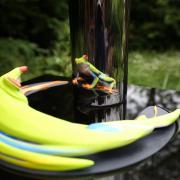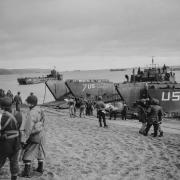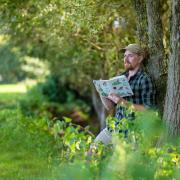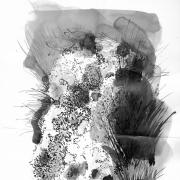It’s 80 years since the D-Day landings in Normandy – and a time during which areas of Devon underwent a dramatic transformation. We look back on when the county played its crucial role in preparations for the largest seaborne invasion in history.
Some are smiling up at the camera. Others are walking, heads down, clutching their M1 Garand rifles. None of these soldiers could possibly have known the enormity of the task that lay ahead. On the day this black-and-white photograph was taken in 1944, these young men were out in the English Riviera sunshine.
This image, supplied by Torquay Museum, and the others like it here help to capture an extraordinary period in the history of what was until then a very ordinary part of the world.
In the run up to June 6, 1944, ‘sleepy old Devon’ became an armed camp where tens of thousands of primarily American troops waited and trained to begin the conquest of Western Europe.

From the palm tree-lined streets of Torquay to the wilds of Dartmoor and the sandy beaches of North Devon, vast areas of the county became home-sweet-home to this army (and navy) of occupation.
Familiar places, such as Torquay’s Strand, Smeaton’s Tower in Plymouth, Brixham Harbour and Woolacombe beach – will look almost unrecognisable to later generations who associate these parts of the county with summer holidays, rather than heavy artillery.
For the Devon residents back then, it must have been a bewildering but exciting time. Almost every parish had its share of American visitors, who brought with them their culture, music, chewing gum and Hershey chocolate bars.
They drove through the narrow country lanes in their jeeps, drank in the local pubs, trained on assault courses near the beaches and played baseball on Plymouth Hoe. And then they were gone.

The soldiers and sailors - many of whom had formed close bonds with Devon locals - disappeared from their camps in late May/early June 1944 to embark on a mission many would not survive. The lucky ones went back to America and carried on with their lives, with Devon just a distant memory.
There is a sadness - almost detectable in the pictures - that hangs over Devon’s D-Day experience. The relationships that never were, the fear, the tough conditions. And of course, there was tragedy in South Devon in April 1944. Up to 749 men died in the disastrous D-Day rehearsal, Exercise Tiger, that took place at Slapton Sands in April 1944 when a convoy of tank landing ships was attacked by German motor torpedo boats.
As the country prepares to mark 80 years since D-Day, these photographs are more important than ever as we try to imagine what life was like for the people in our small part of the world during that intense period of time.
‘It’s important that we’re able to understand our ancestors and what they went through,’ says Dr Harry Bennett, a Second World War historian based at the University of Plymouth. ‘It’s part of our own story.’

Dr Bennett supplied the images here taken by Olin Dows, a United States artist who was stationed in Woolacombe to document scenes of basic training and American troops preparing for combat.
Dr Bennett has also written a short overview of D-Day in Devon, which is due to be published on the university’s website. The account includes information about how soldiers based in and around the county’s towns and villages captured the hearts and minds of our locals before being sent to fight on the beaches of Normandy, France.
Dr Bennett writes: ‘On Plymouth Hoe, and elsewhere, you could watch Americans playing baseball, and the Exeter newspaper carried the pro-baseball results from home to ensure the visitors felt compelled to buy a copy.
‘Swing bands provided the music for dances where lonely troops could meet the local girls. Americans learned to get to grips with the local beer and the etiquette of the pub.’

Through his research, Dr Bennett has uncovered many personal stories from Devon residents about life alongside the troops and how many never found out what happened to their American friends.
‘There’s a sense of belonging and a sense of loss and a sense of ‘that was my youth, but I don’t quite know how the story ended,’ says Dr Bennett, describing the feelings shared by communities up and down the county in the immediate aftermath of D-Day. ‘There are these stories within families that echo down the generations and they’re just simply there,’ he says, adding that it’s important these oral histories are preserved somehow.
‘All history is important but that wartime history and the lessons of that are being lost as we lose more members of that generation.’
With each anniversary that passes, the first-hand insights into this and other D-Day events fade. Local historians agree it’s up to us to pass on the stories and keep the memories alive. Otherwise, all we have left are the photographs.
Operation Overlord: The ‘Day of Days’
D-Day was the largest naval, air and land operation in history, involving hundreds of thousands of men.
Codenamed Operation Overlord, the mission started early on June 6, 1944, when Allied airborne forces parachuted into drop zones across northern France. Ground troops then landed across five assault beaches - Utah, Omaha, Gold, Juno and Sword. By the end of the day, the Allies had established a foothold along the coast and could begin their advance into France.

The build up in Devon
From 1943, substantial numbers of American troops began arriving in the county. There were soon camps everywhere, from Ivybridge to Exmouth.
The British Government offered Saunton Sands, Braunton Burrows and Woolacombe Beach to the US Army for them to use as the site for its Assault Training Centre (ATC). Here, around 10,000 troops took part in training for the Normandy landings. The topography and tides of these beaches were just like those of northern France.

Brigadier General Paul W Thompson, who led the training, is quoted as saying: ‘If Waterloo was won on the playing fields of Eton, surely the sands of North Devon beaches contributed importantly to the success of the assault over the Normandy beaches.’
By 1944, almost every port in South Devon had its own flotilla of invasion craft, waiting to take troops across the Channel.
Aircraft operating from Upottery (RAF Smeatharpe), RAF Chivenor and Harrowbeer would be escorting the mission.

D-Day 80 in Devon
Exhibitions, walks, cream teas, and a military re-enactment at Saunton Beach are just some of the events due to take place this month to commemorate this special anniversary:
Visitors to the D-Day 80 exhibition at Torquay Museum can see some incredible artefacts from the museum’s collection, built up over the decades, thanks largely to donations from the last of the local veterans and their families.
There are audio recordings of wartime memories of Torbay, an original Luftwaffe map of Torquay, US military medals, and much more. There is even amazing video footage of American soldiers boarding transport ships in Torquay and Brixham harbours, which has only recently come to light.
Museum collections manager Barry Chandler has organised exhibitions to mark every significant anniversary since he started working here in 1994.
‘I have got to know a lot of people over that time,’ says Barry, adding that many of these links to the past are no longer with us. ‘I’ve heard so many incredible things first hand. When you’ve been doing something like this for decades, you build up a huge amount of information.’
Barry says he’ll keep organising these exhibitions for as long as he can.
‘I don’t intend to stop,’ he says. ‘The guys that were on those beaches told me time and time again that this should be remembered forever.’
The exhibition runs until September 21.
torquaymuseum.org
In North Devon, they’re preparing to storm the beaches. Living history groups and military vehicle owners from across the country will be descending on Saunton Sands on June 15 for a D-Day enactment. Past events have included a fly past with original Second World War aircraft. This year’s event will be a slightly more scaled down affair because many of the re-enacters are heading to Normandy.
Second World War historian Richard Bass helps to organise the annual event. He has spent many years researching the links between American forces and the west of England during the war and uncovered the forgotten history of the U.S. Assault Training Center, where troops trained on the beaches of North Devon - Saunton Sands, Braunton Burrows and Woolacombe Beach - for their spearhead role on the beaches of Normandy.
‘We try to bring it to life,’ says Richard, adding that the event, which began in 2014, can be quite emotional at times, but ‘it’s important to keep the memory alive.’
assaulttrainingcenterfriends.co.uk
Explore the D-Day military history walk along the coastline of North Devon. North Devon Coastal Heritage, a project by North Devon Coast Areas of Outstanding Natural Beauty (AONB) has put together a map and information booklet to help you find a series of plaques with the D-Day symbol. At each location reading the guide will help you to imagine the events and activities that went on here.
northdevon-aonb.org.uk
A commemorative cream tea has been organised on June 8 by Barnstaple Memory Café. The event takes place at Barnstaple Library.
homeinstead.co.uk
D-Day 80 Upottery will be held on June 5, almost 80 years to the day when planes carrying paratroopers left the airfield in East Devon to take part in the Normandy landings. An entire fleet of Veteran C47 Aircraft is set to depart the runway at Upottery during the historic re-enactment. There will be parachutists, aircrew, living history groups and more.
dday-80.co.uk
Babbacombe Theatre in Torquay is hosting a special live theatre show to commemorate the 80th anniversary of D-Day. There will be heartfelt tributes, laughter, and song.
babbacombe-theatre.com

A personal connection
Many of our local lads from every corner of the county played their part in the Normandy Landings.
My lovely grandfather, John German, who lived in Plymouth, was a tank driver and Lance Corporal with 1st Royal Tank Regiment. He was involved in the campaigns in North Africa and Italy before going ashore in Normandy, the day after D-Day.
Like many of his generation, granddad didn’t talk much about his wartime experiences with us grandkids and we were too young (and self-absorbed) to ask. By the time I became interested, he wasn’t around anymore. He died in 1999.
Sometime after, I came across an interview he had given to his local newspaper, the Western Morning News, to commemorate the 40th anniversary of the D-Day landings.
Here is an extract: ‘On D-Day we were on the way across and we landed the day after D-Day, in the morning. We came off in fairly dry conditions. We got off the beaches as quickly as we could. I was driving and I remember picking my way between white tapes which showed the routes cleared through the minefields.
‘All I could see on the beach was damaged vehicles and the bodies of our dead. The assault people had copped it.’
Mr German’s unit was concentrated in the area behind the beaches.
‘We deployed the best we could in a confined area because the bridgehead had not been exploited by the time we landed,’ he said. ‘We went into action the next morning.’
He added: ‘I was very much aware of the little fields and hedges. It was in complete contrast to the desert warfare and it gave the defenders plenty of cover.’
Mr German came through the immediate aftermath of the landings, but later his tank was hit by a bazooka shell and the commander and gunner were both killed.
‘The co-driver, the wireless operator and I got out,” said Mr German. ‘Luckily the tank did not ‘brew-up’.’
Looking back, Mr German said he remembered the dead in his regiment, many of whom he had known very well.
‘I am rather proud to have taken part,’ he said. ‘But I would not wish it on anyone else.’
Granddad was later selected to drive the lead tank in the victory parade through Berlin in July 1945.



























